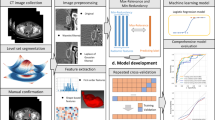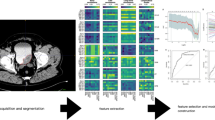Abstract
Purpose
To investigate whether preoperative CT features can be used to predict risk stratification of non-muscle invasive bladder cancer (NMIBC).
Methods
The 168 patients with pathologically confirmed NMIBC who underwent preoperative CT urography were retrospectively analyzed and were divided into training (n = 117) and testing (n = 51) sets. According to the European Association of Urology Guidelines, patients were classified into low-risk (n = 50), medium-risk (n = 23), and high-risk (n = 95) groups. A random over-sample was performed to handle the offset caused by the unbalanced groups. We measured some CT features that may help stratify which for modeling were determined using an F-test-based feature selection with a tenfold cross-validation procedure, and the Gaussian Naive Bayes model was trained on the entire training set. In the testing set, the performance of the model was evaluated.
Results
The selected CT features were the maximum and the minimum diameter of the largest tumor, whether the largest tumor is located at the trigone, and tumor number. In the testing set, the model reached a macro- and micro- AUC of 0.783 and 0.745 with an accuracy of 0.529. As for the one-vs-rest problem, the model was most effective in identifying low-risk individuals, with an AUC, accuracy, sensitivity, and specificity of 0.870, 0.647, 1.000, and 0.438, respectively; the medium-risk group reached 0.814, 0.882, 0.250, and 0.936, respectively; the identification of the high-risk group was harder, going 0.665, 0.529, 0.250, and 0.870, respectively.
Conclusion
It is feasible to predict the risk stratification of NMIBC using preoperative CT features.
Graphical abstract





Similar content being viewed by others
Data availability
The datasets used and analyzed during the current study are available from the corresponding author on reasonable request.
Code availability
Not applicable.
Abbreviations
- ADC:
-
Apparent diffusion coefficient
- AUA:
-
American Urological Association
- AUC:
-
Area under the curve
- BCa:
-
Bladder cancer
- CI:
-
Confidence interval
- CIS:
-
Carcinoma in situ
- CT:
-
Computed tomography
- CTU:
-
CT urography
- EAU:
-
European Association of Urology
- HU:
-
Hounsfield Unit
- NMIBC:
-
Non-muscle invasive BCa
- ROC:
-
Receiver operating characteristic
- ROI:
-
Region of interest
- TURBT:
-
Transurethral resection of bladder tumor
References
Siegel RL, Miller KD, Fuchs HE, Jemal A (2021) Cancer Statistics, 2021. CA Cancer J Clin 71:7-33. https://doi.org/10.3322/caac.21654
Siegel RL, Miller KD, Jemal A (2020) Cancer statistics, 2020. CA Cancer J Clin 70:7-30. https://doi.org/10.3322/caac.21590
Pang C, Guan Y, Li H, Chen W, Zhu G (2016) Urologic cancer in China. Jpn J Clin Oncol 46:497-501. https://doi.org/10.1093/jjco/hyw034
Witjes JA (2021) Follow-up in non-muscle invasive bladder cancer: facts and future. World J Urol 39:4047-4053. https://doi.org/10.1007/s00345-020-03569-2
Svatek RS, Hollenbeck BK, Holmang S, et al (2014) The economics of bladder cancer: costs and considerations of caring for this disease. Eur Urol 66:253-262. https://doi.org/10.1016/j.eururo.2014.01.006
Babjuk M, Bohle A, Burger M, et al (2017) EAU Guidelines on Non-Muscle-invasive Urothelial Carcinoma of the Bladder: Update 2016. Eur Urol 71:447-461. https://doi.org/10.1016/j.eururo.2016.05.041
Babjuk M, Burger M, Capoun O, et al (2022) European Association of Urology Guidelines on Non-muscle-invasive Bladder Cancer (Ta, T1, and Carcinoma in Situ). Eur Urol 81:75-94. https://doi.org/10.1016/j.eururo.2021.08.010
Spiess PE, Agarwal N, Bangs R, et al (2017) Bladder Cancer, Version 5.2017, NCCN Clinical Practice Guidelines in Oncology. J Natl Compr Canc Netw 15:1240-1267. https://doi.org/10.6004/jnccn.2017.0156
Chang SS, Boorjian SA, Chou R, et al (2016) Diagnosis and Treatment of Non-Muscle Invasive Bladder Cancer: AUA/SUO Guideline. J Urol 196:1021-1029. https://doi.org/10.1016/j.juro.2016.06.049
Kim LHC, Patel MI (2020) Transurethral resection of bladder tumor (TURBT). Transl Androl Urol 9:3056-3072. https://doi.org/10.21037/tau.2019.09.38
Soukup V, Capoun O, Cohen D, et al (2020) Risk Stratification Tools and Prognostic Models in Non-muscle-invasive Bladder Cancer: A Critical Assessment from the European Association of Urology Non-muscle-invasive Bladder Cancer Guidelines Panel. Eur Urol Focus 6:479-489. https://doi.org/10.1016/j.euf.2018.11.005
Capalbo E, Kluzer A, Peli M, Cosentino M, Berti E, Cariati M (2015) Bladder cancer diagnosis: the role of CT urography. Tumori 101:412-417. https://doi.org/10.5301/tj.50003311
Zhang G, Wu Z, Xu L, et al (2021) Deep Learning on Enhanced CT Images Can Predict the Muscular Invasiveness of Bladder Cancer. Front Oncol 11:654685
Sadow CA, Silverman SG, O'Leary MP, Signorovitch JE (2008) Bladder cancer detection with CT urography in an Academic Medical Center. Radiology 249:195-202
Panebianco V, Narumi Y, Altun E, et al (2018) Multiparametric Magnetic Resonance Imaging for Bladder Cancer: Development of VI-RADS (Vesical Imaging-Reporting And Data System). Eur Urol 74:294-306
DeGeorge KC, Holt HR, Hodges SC (2017) Bladder Cancer: Diagnosis and Treatment. Am Fam Physician 96:507-514
Reuter VE (2006) The pathology of bladder cancer. Urology 67:11-17; discussion 17-18
Miyake M, Matsuyama H, Teramukai S, et al (2020) A new risk stratification model for intravesical recurrence, disease progression, and cancer-specific death in patients with non-muscle invasive bladder cancer: the J-NICE risk tables. Int J Clin Oncol 25:1364-1376
Wang Z, Gao W, Li J, Wang T, Zhu M, Duan Y (2020) Development and Validation of a Novel Recurrence Risk Stratification for Initial Non-Muscle Invasive Bladder Cancer in the Han Chinese Population. J Cancer 11:1668-1678
Li L, Na R, Mi T, Cheng H, Ma L, Chen G (2021) Medical Image Diagnostic Value of Computed Tomography for Bladder Tumors. Comput Math Methods Med 2021:3781028
Pons F, Orsola A, Morote J, Bellmunt J (2011) Variant forms of bladder cancer: basic considerations on treatment approaches. Curr Oncol Rep 13:216-221
Fukushima H, Moriyama S, Waseda Y, et al (2021) Significance of Bladder Neck Involvement in Risk Substratification of Intermediate-Risk Non-muscle-invasive Bladder Cancer. Eur Urol Focus 7:366-372
Mayerhoefer ME, Materka A, Langs G, et al (2020) Introduction to Radiomics. J Nucl Med 61:488-495
Ye L, Chen Y, Xu H, et al (2022) Radiomics of Contrast-Enhanced Computed Tomography: A Potential Biomarker for Pretreatment Prediction of the Response to Bacillus Calmette-Guerin Immunotherapy in Non-Muscle-Invasive Bladder Cancer. Front Cell Dev Biol 10:814388
Acknowledgements
Li Mao, Xin Xiao, and Xiuli Li are employees of Deepwise AI Lab, Deepwise Healthcare, which contributed to the development of the CT-based prediction models described in the study. We’d like to thank Deepwise AI Lab, Deepwise Healthcare. for their technical support in this study.
Funding
This work was supported by National High Level Hospital Clinical Research Funding (Grant Nos. 2022-PUMCH-A-035, 2022-PUMCH-B-069, 2022-PUMCH-A-033), the Natural Science Foundation of China (Grant No. 81901742), the CAMS Innovation Fund for Medical Sciences (Grant No. 2022-I2M-C&T-B-019), the 2021 Key clinical Specialty Program of Beijing, Beijing Municipal Key Clinical Specialty Excellence Program.
Author information
Authors and Affiliations
Contributions
LC, GZ, YX, ZJ and HS: guarantor of integrity of the entire study, GZ: study concepts and design, LC: literature research, LX, XZ, and JZ: clinical studies, JZ, XB, and RJ: experimental studies/data analysis, LM, XL, and XX: statistical analysis, LC and GZ: manuscript preparation, YX, ZJ, and HS: manuscript editing.
Corresponding authors
Ethics declarations
Conflict of interest
The authors of this manuscript declare relationships with the following company: Deepwise Healthcare. Li Mao, Xin Xiao, and Xiuli Li are employees of Deepwise Healthcare. The remaining authors declare they have no competing interests.
Ethical approval
Institutional Review Board approval was obtained.
Consent to participate
Written informed consent was waived by the Institutional Review Board.
Consent for publication
Written informed consent for publication was obtained from all participants.
Additional information
Publisher's Note
Springer Nature remains neutral with regard to jurisdictional claims in published maps and institutional affiliations.
Supplementary Information
Below is the link to the electronic supplementary material.
Rights and permissions
Springer Nature or its licensor (e.g. a society or other partner) holds exclusive rights to this article under a publishing agreement with the author(s) or other rightsholder(s); author self-archiving of the accepted manuscript version of this article is solely governed by the terms of such publishing agreement and applicable law.
About this article
Cite this article
Chen, L., Zhang, G., Xu, L. et al. Preoperative CT features to predict risk stratification of non-muscle invasive bladder cancer. Abdom Radiol 48, 659–668 (2023). https://doi.org/10.1007/s00261-022-03730-y
Received:
Revised:
Accepted:
Published:
Issue Date:
DOI: https://doi.org/10.1007/s00261-022-03730-y




